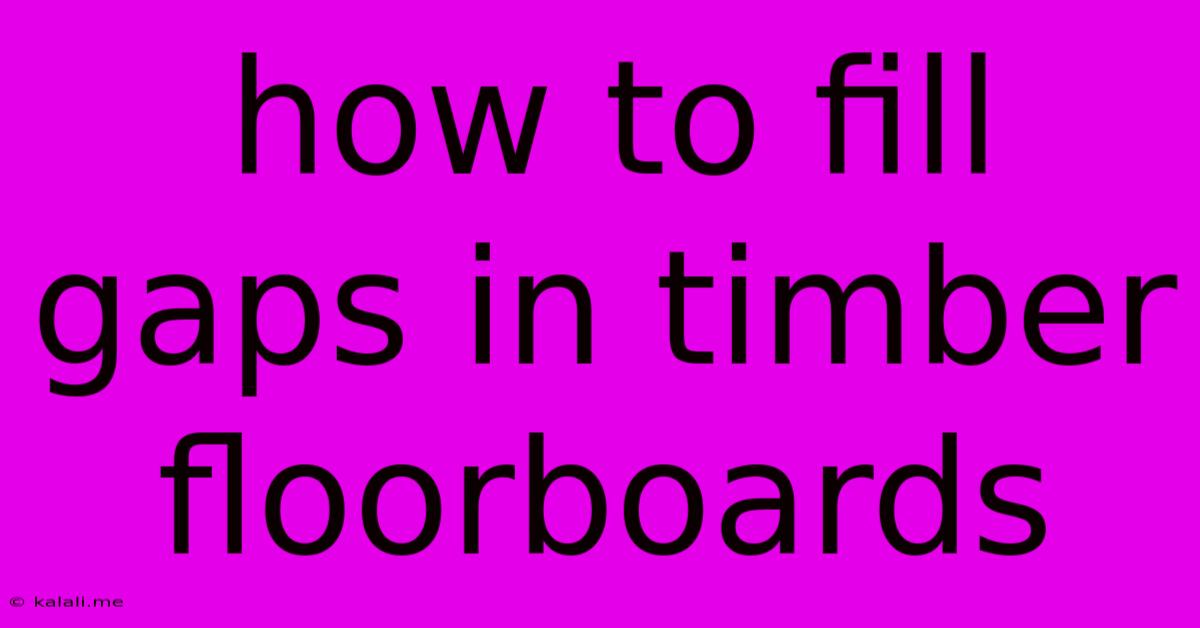How To Fill Gaps In Timber Floorboards
Kalali
Jun 01, 2025 · 3 min read

Table of Contents
How to Fill Gaps in Timber Floorboards: A Comprehensive Guide
Gaps appearing between timber floorboards are a common problem, often caused by seasonal changes in humidity and temperature. These gaps not only detract from the aesthetic appeal of your floors but can also let in drafts, dust, and even pests. Fortunately, filling these gaps is a manageable DIY project, though the best approach depends on the size and nature of the gaps. This guide will walk you through various methods to effectively and efficiently repair your timber floorboards.
Understanding the Causes of Gaps
Before you start filling, it's crucial to understand why the gaps appeared. This will help you determine the best long-term solution. Common causes include:
- Seasonal changes: Timber expands and contracts with changes in humidity and temperature. Dry weather leads to shrinkage and gaps, while humid weather can cause swelling.
- Poor installation: Incorrectly installed floorboards are more prone to gaps over time. Insufficient expansion gaps around the perimeter of the room can also contribute.
- Age and wear: Older floorboards are more likely to show signs of wear and tear, leading to wider gaps.
- Underlying structural issues: In some cases, gaps can be indicative of more serious problems, such as foundation settling or joist movement.
Assessing the Gaps and Choosing the Right Filler
The size of the gap will determine the best filling material and method:
- Small gaps (less than 3mm): These can often be filled with wood filler. Choose a filler that matches the color of your floorboards as closely as possible.
- Medium gaps (3mm – 10mm): For medium gaps, you might consider using wood putty, a flexible wood filler, or even thin strips of wood.
- Large gaps (over 10mm): Large gaps require a more substantial repair, potentially involving replacing damaged floorboards or using wood wedges to support new filler.
Materials You'll Need
Depending on the gap size and chosen method, you might need some or all of these materials:
- Wood filler: Choose a high-quality wood filler that matches your floorboards' color and type.
- Wood putty: A more flexible option for larger gaps.
- Wood wedges or strips: For larger gaps requiring support.
- Putty knife or filling knife: For applying the filler smoothly.
- Sandpaper: For smoothing the filler after it dries.
- Vacuum cleaner: To remove dust and debris.
- Floorboard cleaner: To clean the area prior to filling.
- Wood stain (optional): To match the filled area to the surrounding floorboards.
- Floor sealant (optional): For added protection and durability.
Step-by-Step Guide to Filling Gaps
1. Preparation: Thoroughly clean the area around the gaps, removing dust, dirt, and debris. Vacuum thoroughly.
2. Applying the Filler: For small gaps, apply the wood filler using a putty knife, pressing it firmly into the gap. For larger gaps, use wood wedges or strips for support before applying the filler or putty. Ensure the filler is level with the surrounding floorboards.
3. Drying and Smoothing: Allow the filler to dry completely according to the manufacturer's instructions. Once dry, use sandpaper to smooth the filled area, blending it seamlessly with the existing floorboards.
4. Finishing Touches: If necessary, apply wood stain to match the color of the surrounding floorboards. Once the stain is dry, apply a floor sealant to protect the repaired area from moisture and wear.
5. Consider Professional Help: For extensive damage or significant gaps, consider consulting a flooring professional. They can assess the underlying cause of the problem and provide a more permanent solution.
Maintaining Your Timber Floorboards
Regular maintenance is key to preventing future gaps. This includes:
- Regular cleaning: Keep your floors clean and free of debris.
- Humidity control: Maintain consistent humidity levels in your home to minimize expansion and contraction. A dehumidifier in humid climates and a humidifier in dry climates can help.
- Protective measures: Use rugs and mats in high-traffic areas to reduce wear and tear.
By following these steps, you can effectively fill gaps in your timber floorboards and restore their beauty and functionality. Remember, patience and attention to detail are crucial for a professional-looking finish.
Latest Posts
Latest Posts
-
Typeerror Unsupported Operand Type S For List And List
Jun 03, 2025
-
How To Wire A Single Pole Switch
Jun 03, 2025
-
How Many Cups In A Pound Of Icing Sugar
Jun 03, 2025
-
How To Tell If Coconut Is Bad
Jun 03, 2025
-
Small Black Bug With Two Antenna
Jun 03, 2025
Related Post
Thank you for visiting our website which covers about How To Fill Gaps In Timber Floorboards . We hope the information provided has been useful to you. Feel free to contact us if you have any questions or need further assistance. See you next time and don't miss to bookmark.